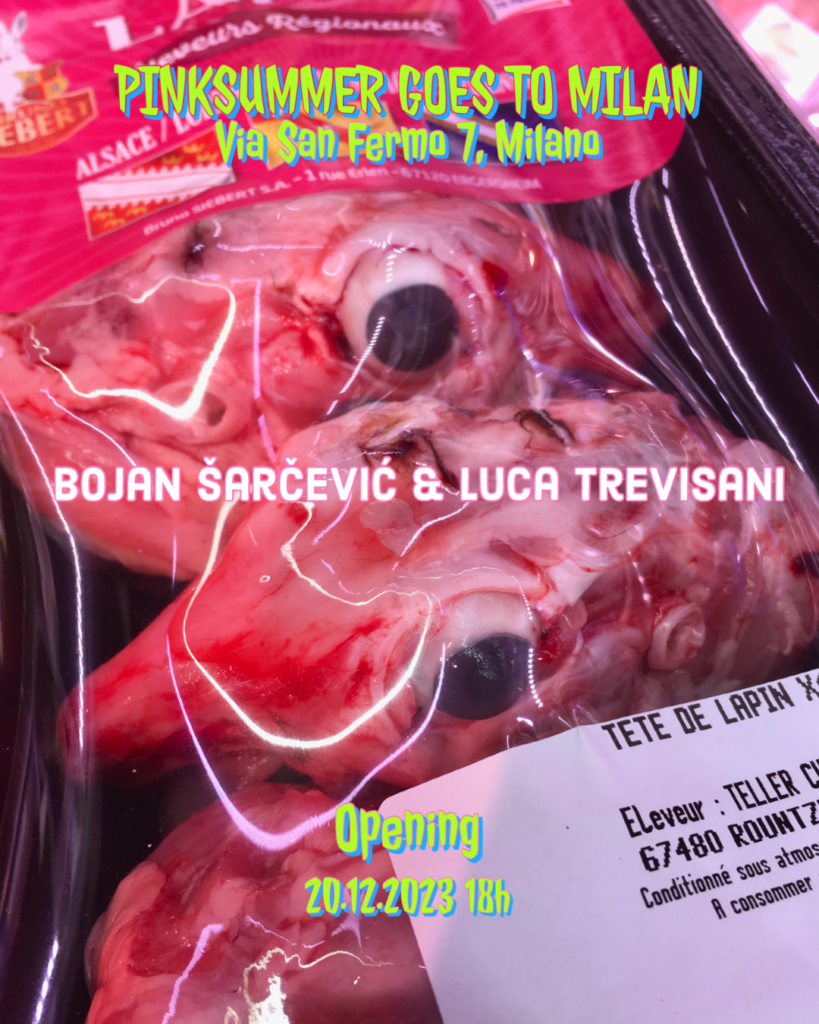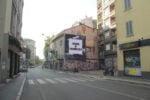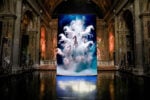Pinksummer goes to Milan – Bojan Šarčević & Luca Trevisani

La Galleria Pinksummer, in trasferta a Milano, presenta Bojan Šarčević in dialogo con Luca Trevisani.
Comunicato stampa
L’indumento di pelle è come una seconda pelle, che potrebbe essere vista come un involucro sostitutivo, essendo la nostra pelle un involucro e una sorta di indumento primario.
Un nuovo corpo di lavori che ha a che fare con il concetto di mostruosità.
La trasformazione di una giacca di pelle di seconda mano, simbolo di ribellione, indipendenza, aggressività e anche come primo strumento che ha permesso alla specie umana di regolare la temperatura del corpo nel clima duro.
Una sorta di “scuoiatura” di un indumento di moda per trasformarlo in una rappresentazione.
Inserendo nelle cuciture aperte dell’indumento gli occhi da tassodermista, la figurazione allude alla bestialità e a un presenza minacciosa che ci osserva. Il cuoio senza forma rimanda al test di Roscharch.
Il concetto di mostruosità può essere visto come una formalizzazione delle ansie perché rappresenta una manifestazione visiva delle nostre paure circa il mondo intorno a noi e il tempo in cui viviamo.
Le figure mostruose sono spesso una rappresentazione dell’ignoto, dell’anormale, del minaccioso e in quanto tali, incarnano la nostra angoscia più profonda.»
Bojan Šarčević - Vieille Lâcheté
«Del taglio è una serie di coltelli in guisa degli animali che mangiamo e che tagliamo, costruiti per stabilire una corrispondenza tra forma, materiali, usi e sensi.
Un arcipelago di forme taglienti, oggetti ma anche soggetti, che si fanno carico della gestione spirituale del rapporto di forza che intercorre tra il nostro stomaco e il mondo, sublimandosi in talismani contraddittori e provocatori. Le diverse tipologie delle forme di vita, come fantasmi per mettere in crisi il nostro rapporto passivo e automatico con l’idea di cibo, dieta e materia. La morfologia del vivente come grimaldello in cui incarnare tutta una serie di tensioni e rapporti che troppo spesso rimangono silenti e invisibili, per indagare la percezione occidentale del mondo, spostarne il baricentro, dagli occhi ad altre parti della mente.
Il taglio come forma del pensiero, come figura scultorea con cui trovare le buone articolazioni del mondo, il taglio e la sua paradossale dolcezza, il taglio come gesto culturale e cultuale, come mitologema. La bocca, la mano, il nutrimento: una scrittura perenne dove la distinzione tra il sé, il corpo e l’ambiente non sono più così certe.
Il nutrimento come scambio energetico, quale incessante produzione e distruzione di forme, supremo crogiolo di metamorfosi. Che per esser compreso va formalizzato, coagulato, replicato.
Fare scultura è quel modo specifico in cui l’uomo sembra aver sempre cercato di fermare l'impermanenza della vita, per dare al tempo un corpo solido, e fare dell’attimo la Storia. È una pratica energetica, un’esperienza che incarna forze immateriali, un atto di immaginazione che unisce le parti occulte e visibili del mondo in un impasto inedito.
Tagliare, separare, ma anche raddrizzare, o liberare, è il tabù del pericolo. I coltelli sono oggetti apotropaici pensati per allontanare la malasorte, unendo una funzione protettiva e devozionale a quella decorativa. Un oggetto ordinario ma anche l’espressione di epos popolare, strumento essenziale per l’economia agropastorale, simbolo di legami sociali, incarnazione del potere.
Lavorare su un paradigma archetipico come quello del coltello, su un fossile culturale, è un modo di disarticolare la nostra idea di tecnologia, di progresso digitale e di svincolarsi dalle frenesie e dagli stereotipi del presente. Il passato è il solo futuro del nostro futuro.»
«When it comes to the external environment we are in relationship and in exchange through our skin. We are in contact with impressions of humidity, dryness, heat, these are sensory and sensual relationships.
Leather garment as second skin, which has come to seem like a replacement envelope, as our skin is an envelope and a kind of first garment.
A new body of works deals with the concept of monstrosity.
The transformation of second hand worn leather jackets, as a stand-in sign of rebellion, independence, thuggishness and also as first item that allowed human specie to regulate their body temperature in harsh climate.
A sort of ‘skinning’ of a fashion garment and transforming into a representation.
Inserting into garment’s sawing seams the taxidermist eyes, the figuration alludes to a bestiality and menacing presence that is observing us. As a formless leather Roscharch test looking back.
The concept of monstrosity can be seen as a formalization of anxieties because it represents a visual manifestation of our fears about the world around us and about the time we live in.
Monstrous figures are often representations of the unknown, the abnormal, and the threatening, and as such, they serve as symbols of our deepest angst.»
Del taglio is a series of knives in the guise of the animals we eat and cut, constructed to establish a correspondence between material, form, uses and senses. An archipelago of sharp forms, objects but also subjects, that take on the spiritual management of the power relationship between our stomach and the world, sublimating into contradictory and provocative talismans. The different kind of life forms as ghosts to challenge our passive and automatic relationship with the idea of food, diet and matter. The morphology of the living as a pick with which to embody a whole series of tensions and relationships that too often remain silent and invisible, and to investigate the Western perception of the world, and shift its center of gravity from the eyes to other parts of the mind.
The cut as a form of thought, as a sculptural figure with which to find the good articulations of the world, the cut and its paradoxical sweetness, the cut as a cultural and cultic gesture, as mythologema. The mouth, the hand, the nurture: a never-ending writing where the distinction between the self, the body and the environment are no longer so certain.
Nurture as energy exchange, as the incessant production and destruction of forms, the supreme distiller of metamorphosis. Which to be understood must be formalized, coagulated, replicated.
Making sculpture is that specific way in which man seems to have always tried to stop the impermanence of life, to give time a solid body, and make the moment the story. It is an energetic practice, an experience that embodies immaterial forces, an act of imagination that unites the occult and visible parts of the world in an unprecedented mixture.
Cutting, separating, but also straightening, or freeing, and the taboo of danger. Knives are apotropaic objects designed to ward off bad luck, combining a protective and devotional function with a decorative one. An ordinary object but also an expression of popular epos, an essential tool for the agro-pastoral economy, a symbol of social ties, and an embodiment of power.
Working on an archetypal paradigm such as the knife, on a cultural fossil, is a way of disarticulating our idea of technology, of digital progress, and of freeing ourselves from the frenzies and stereotypes of the present. The past is the only future of our future.
Luca Trevisani - Del taglio
We look forward to seeing you on Wednesday, December 20, at 6 p.m. at Via San Fermo 7, Milan.



